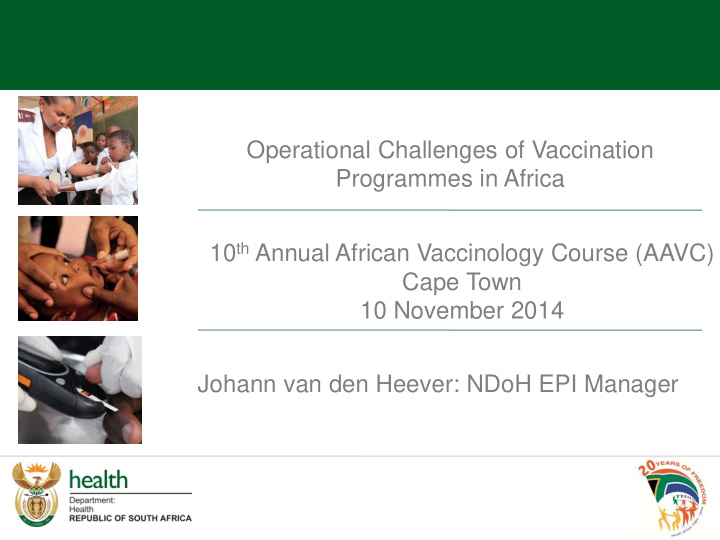



Operational Challenges of Vaccination Programmes in Africa 10 th Annual African Vaccinology Course (AAVC) Cape Town 10 November 2014 Johann van den Heever: NDoH EPI Manager
Outline – Challenges of a Vaccination Systems Environment in Africa – Challenges of the 5 Operational Components of Vaccination Systems – Challenges of the 3 supportive elements of vaccination programmes in Africa – Conclusion & way forward
Challenges of a Vaccination Systems Environment • Health sector reforms • Increasing complexities Vaccination systems Health Systems External environment • Macroeconomic changes • External Debt • National structural changes • New partners
Operational components of Vaccination systems Vaccine Supply & Temperature Quality chain & Logistics Service Delivery Data & Advocacy & Surveillance Communication
Five operational components (1) 1. VACCINE SUPPLY & QUALITY 2. Vaccine-Preventable Disease priorities: traditional vaccines and additional Country-specific vaccine preventable diseases e.g. meningitis, yellow fever – Target populations: children/adolescents/mothers/others – Budget: Self-financed/GAVI supported: PAHO – like procurement for Africa? – Forecasting vaccine needs: schedule & doses; vaccine presentation (single/multi-dose); routine & outbreak response – Tender processes & procurement of vaccines: timelines/vaccine pipelines – Vaccine utilisation monitoring, including wastage – Immunisation safety: quality monitoring: National Control Laboratory
Five operational components (2) 2. EQUIPMENT, TEMPERATURE CHAIN & LOGISTICS – Temperature chain: maintaining & monitoring optimal ranges; monitoring equipment & back-up energy supplies – Available storage capacity: targets, schedules (doses required), usage/wastage (estimates vs. take-off) – Transport: Methods & frequency of supply, Number of units & facilities to supply; frequency of delivery; Monitoring & maintaining optimal temperatures during delivery – Stock management of vaccines: systems; Equipment (fridges/storage rooms); monitoring devices & methods – Dry storage/ other materials (syringes (types), needles, etc.) – Waste disposal: routine, for supplementary activities & during outbreaks: environmental & safety concerns – Maintenance of equipment: Cold rooms/Fridges: Type, maintenance & inventory, monitoring, replacement strategy & budget
Five Operational Components (3) 3. DATA & SURVEILLANCE DATA SYSTEM – Targets (?including private vaccinations sector), Indicators & monitoring of performance (routine & supplementary) against disease prevalence/incidence – Recording, collating, analysis, reporting & feedback: electronic or paper-based – Record keeping and reporting to National & UN bodies (JRF) – SUPPORTS ALL COMPONENTS SURVEILLANCE SYSTEM – set-up (public & private) & monitoring (weekly active surveillance – timeliness & completeness of reporting, including zero reporting) of VPDs & Safety monitoring: AEFIs – Laboratory testing & classification of cases (NPEC) – Laboratory containment (NTF) – Overseeing elimination & eradication processes (NCC, ICCC, ARCC & IMB / Independent Monitoring Board) – Record keeping and reporting to National & UN bodies (Annual Polio Eradication Reports to ARCC)
Five Operational Components (4) 4. ADVOCACY, COMMUNICATION & SOCIAL MOBILISATION: – Information-Education-Communication materials & methods (including Health Information & Communications) on global, regional and country- specific disease prevalence and incidence: health workers and the public – Personal communication: vaccine hesitators – Interpersonal communication: partners – Social mobilisation: community participation, within socio-political and cultural norms and standards – Political and media advocacy & information – Intersectoral collaboration
Five Operational Components (5) PROGRAMME AND SERVICE DELIVERY: CORE, GUIDED BY – Global Vaccine Action Plan: WHO, UNICEF – MDGs/SDGs – WHO AFRO Region, sub-regional strategies & guidelines – Country Health Strategies & priorities: – E.g. National Development Plan: Vision 2030 – National Strategic Plan 2016 – 2019 – National Service Delivery Plan – Annual Performance Plan with indicators – 16 Key MDG countdown interventions – Provincial & District Health Plans – RTH Booklets/Child Health Cards & – Vaccination Monitoring Charts
Five Operational Components (5)… 5. SERVICE DELIVERY (continued) – Policies (& recommendations from NITAG (National Immunisation Technical Advisory Group), guidelines, standard operating procedures – Training, monitoring, evaluation & supervision – Needs identification: informed by Reviews, Surveys – Supportive partners
Five Operational Components (5) 5. SERVICE DELIVERY: To ensure quality & safety of Programmes – Strategies and activities in administering vaccines: integrated vs. stand-alone • Budget: self-financed/GAVI-supported • Static/fixed and Outreach/mobile Services & methods of transport • Routine (keep-up) and • Catch-up immunisation drive: (those who do not attend routinely): Child Health Days; Periodic Intensification of Routine Immunisation (PIRI) • Supplementary Immunisation Activities (SIA)/Campaigns: to minimise the number of susceptibles (unvaccinated & under-vaccinated): large number of cohort, in a large geographical area, over a short time period, in order to interrupt transmission (definite start & finish) • New vaccine introduction timelines
Five Operational Components (5) 5. SERVICE DELIVERY: To ensure quality & safety of Programmes – Strategies and activities in administering vaccines: • Reach Every Child in Every household in every District & Community (RED/REC) Strategy • Continuous vaccine availability • Safe vaccination practices • Surveillance: AEFI & pharmacovigilance • ACSM to improve acceptability • Improving accessibility: “Every day is an immunisation day” – no missed opportunities • Improving data quality
3 Supportive elements of a Vaccination system Operations 1. Vaccine Supply & Quality 2. Logistics 3. Data & Surveillance Advocacy & Communication 4. Service Delivery 5. Management
Supportive Elements of a Vaccination System (1) 1. MANAGEMENT – Policy formulation – Setting of Standards: Standard Operating Procedures, Guidelines – Planning & Micro-planning: CMyP – Sharing information & collaboration with Development- & Operations partners – Quality Assurance – Monitoring & Evaluation: Supportive Supervision
Supportive Elements of a Vaccination System (2) 2. STRENGTHENING HUMAN & INSTITUTIONAL RESOURCES – Staffing of programmes: self-reliance vs. reliance on development partners – Ensuring adequate African resource capacity, Management training & development within a competitive world – Supportive Personnel administration/management & development – Institutional support: provide technical information, operational research support and capacity, etc.
Supportive Elements of a Vaccination System(3) 3. SUSTAINABLE FINANCING • Adequate budgeting for integrated EPI activities • Effective management of available financial resources • Increased allocation of financial resources in the long term, based on work study recommendations
The delicate nature of vaccination systems in Africa
Knowledge, Skills & Practicing produces Confidence
Acknowledgements • WHO • NDoH, South Africa
Recommend
More recommend